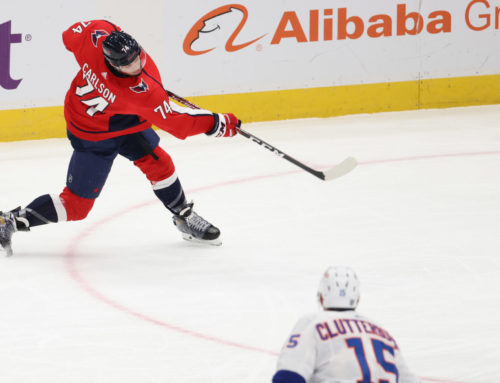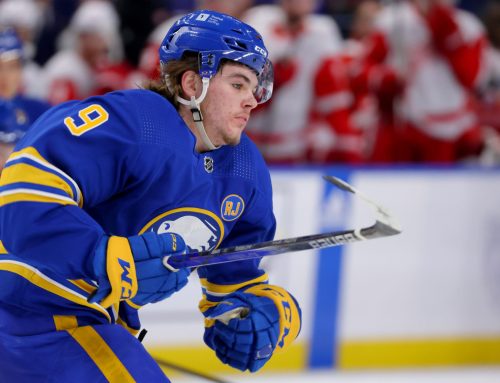
Throughout the summer, I’m going through each team alphabetically to review the relevant fantasy performances in 2016-17, and what that could mean for 2017-18. The next team on the list – at the risk of poking the beehive – is the Toronto Maple Leafs.
Auston Matthews
Like there’s anyone else to start with.
Expectations in Leaf Land were high with Matthews, which is always a concern for a rookie. It’s safe to say he shattered all expectations by being the first teenage rookie since Eric Lindros to score 40 goals in a single season. In fact, he’s just the sixth teenage rookie in NHL history to do so, and four of the names on that list are in the Hall of Fame:
Ok, so the initial concern here is that he scored 29 goals at five-on-five, shooting 13.43 percent in the process. Only four regular forwards have shot at a higher percentage over the last three years, just to frame how difficult to repeat that from one season to the next. Maybe that is his natural shooting talent – I doubt it, but maybe. All I’m saying is that expecting that to repeat is a very high bar.
On the other hand, it’s not like his scoring totals were purely a result of a percentage binge. He was top-10 among forwards with 1000 five-on-five minutes in shot attempts, and top-5 in shots on goal. Being such a heavy volume shooter is good for goal scoring.
Also, even if he does regress at five-on-five, there’s room for improvement on the power play. He did manage eight PP goals, and that’s a solid number. But the power play time was very spread out, as they had seven forwards between 170 and 202 PP minutes overall as they more or less played two even PP units. My hope is that Mike Babcock decides, “hey, maybe we should give more ice time to Matthews and less to Leo Komarov” but we’ll see.
There’s also the question of five-on-five ice time. Yes, he led the Leafs in this regard, which is good. But the team really spread out things among their top three lines so even though Matthews led the team by about 30 seconds at five-on-five per game, he finished outside the top-40 forwards in ice time per game across the league (minimum 500 total minutes). Leading the team is nice; being among the league leaders would be better.
Aside from some more ice time on both the power play and at five-on-five, there’s not much to nitpick. It was one of the greatest rookie seasons in recent memory, and the only question now is how high to draft him. I don’t see him slipping out of the first round, so it’s a matter where he slots into the top-12.
William Nylander
Once Babcock figured out to player Nylander and Matthews together consistently, the Leafs were better for it. These are their without-with you numbers, via the now-defunct Puckalytics.com:

What is curious there is the team only shot 6.2 percent at five-on-five with those two on the ice. I find it hard to believe that’s anywhere near a sustainable number, and that should increase significantly next year.
Aside from that, Nylander’s season, as anyone who has paid any attention to hockey in the last four months knows, was outstanding. He became just the ninth rookie age 20 or younger since the lockout of 2005 to amass 20 goals, 60 points, and 200 shots on goal. The rest of the list is exclusive.
One area that needs some improvement is five-on-five scoring. This isn’t to say it was abysmal; 1.72 points per 60 minutes for nearly any rookie would typically be a very good season. However, the team only scored 2.33 goals per 60 minutes at five-on-five when he was on the ice with Matthews, and 2.11 when Nylander was on the ice without him. As I mentioned above, that shooting percentage should right itself by a huge margin next year, I just worry about a young player relying so heavily on power-play points.
Of course, having a huge number of power-play points (26!) is great for fantasy value in and of itself. As with Matthews, hopefully this team focuses on one power-play unit more than the other next year, with Nylander on that unit. Anecdotally, he could see the ice very well, and had top-end passing skills. He did have roughly the same assist rate last year as guys like John Tavares, Mark Stone, and Alexander Wennberg, so if he can find that scoring chemistry with Matthews, this will be a feared duo in very short order.
For roto leagues, I think Nylander’s potential draft position is a far more interesting discussion than that of Matthews. By most rookie season standards, 2016-17 was a great year, but does he get a bit overlooked in the fantasy game because of his line mate, or is this a budding Jamie Benn–Tyler Seguin situation where both are drafted high? Keep in mind that Nylander was sometimes a victim of the Babcock doghouse, finding himself on the fourth line at times last year. Does that continue? I’m very, very interested to see where his ADP falls.
Coming off a season where he managed 3.4 shots per game but only shot 6.5 percent, Kadri’s range of outcomes seemed very wide for the 2016-17 season. He finally lived up to the hopes fantasy owners had for him for years, though, posting his first 30-goal season, as well as his first 60-point one.
Kadri’s 13.6 percent shooting might seem high, but keep in mind that from 2012 through 2015, he shot 13 percent. It’s not like what he managed was out of the ordinary from him, it was just the 2015-16 season where he had a high volume and low percentage that was out of the ordinary. I hate to credit everything to shot selection, but looking at his shot maps at five-on-five from 2015-16 and 2016-17, it’s clear he took fewer shots from 30-40 feet away at the tops of the circles, and focused more on shots from 20-30 feet in the slot (via HockeyViz):


His 12 power-play goals were a lot – he had 18 in his career before that year – but at the least, his percentages weren’t extreme. He scored on 10.4 percent of unblocked shot attempts he took, but he also achieved that conversion level in 2013-14, as well as nine percent in 2012-13. His percentages suffered as the team declined from 2014-16, but as the team improved, so did he. He probably doesn’t reach 12 PP tallies, but he can push for double-digits if he’s given similar deployment as last year.
The shot rate declined, but he was more aware of where he was shooting from, an indication that he wanted to avoid that 6.5 percent conversion rate again. With all the ice time being spread out on the roster, and Kadri’s role unlikely to change very much, I don’t know if it gets any better than what he did in this season. However, I do think he can be a 25-goal, 55-point player with solid peripherals, particularly in leagues that count hits. He has a few other teammates with more pure upside offensively, but Kadri might be the best value come draft day.
****
I know there were other fantasy performances well worth talking about, particularly Mitch Marner and James van Riemsdyk, but there will be enough written about them in the coming months.
****
A crucial conversation to have at this moment is just how to go about drafting the Leafs for 2017-18. They should be one of the top offensive teams in the league again, and even without including their Big Three sophomore players, guys like Kadri, van Riemsdyk, Tyler Bozak, Connor Brown, Morgan Rielly, Nikita Zaitsev, and Jake Gardiner will all warrant fantasy consideration at varying levels.
The question is how to draft them, and how many.
I’m sure there are people out there who will be targeting both Matthews and Nylander. Drafting line mates can be a huge boon for fantasy rosters – just think of players who wrangled both Patrick Kane and Artemi Panarin in 2015-16, Jamie Benn and Tyler Seguin in 2013-14 (and later), Nicklas Backstrom and Alex Ovechkin for the better part of a decade, and so on.
It’s important to keep in mind the fragility of such a strategy, however – one injury can ruin two seasons. Think of how Seguin performed without a healthy Benn beside him for 2016-17; how Sean Monahan has struggled when Johnny Gaudreau was injured; the scoring of non-Triplets skaters when Steven Stamkos has been out of the lineup. There are countless examples like this, and yes, if a player gets hurt that does give a rise in value to another, but then you’re also fighting with league mates for the same player at the waiver wire.
There is immense upside to such a strategy, obviously. If Matthews keeps improving and has a 40-goal, 80-point season, with Nylander at 25 goals and 70 points, drafting both of them in the first and third rounds (or wherever the ADP falls) can be wonderful for fantasy owners. But what if Matthews breaks his hand and Nylander is playing with Matt Martin for 20 games? Or if Nylander suffers a high-ankle sprain and Matthews loses his playmaker? That’s the kind of risk/reward fantasy owners need to keep in mind, and figure out how much risk they’re willing to tolerate. It’s a strategy that can put you in the running to win a league, or sink a season.
One Comment
Leave A Comment
You must be logged in to post a comment.





 MTL
MTL
 PIT
PIT FLA
FLA S.J
S.J CGY
CGY MIN
MIN VAN
VAN

The production of the Leafs’ forwards will depend on how Marleau is used. If he’s on the 3rd line and 2nd PP unit, he may not affect things too much, but if he’s on the 1st or 2nd line and 1st PP unit, he could prevent some players from posting better numbers than last year or even make them decrease somewhat. I doubt the Leafs would have signed him for that much for that long (given his age) if he weren’t going to see at least as much icetime as he did in San Jose.
I’d be surprised of Komarov sees any time on the powerplay unless the Leafs suffer some LTI to their top-6 forwards.